What Mid-day meals mean for rural India?
Anirban Bhattacharya

Ram sagar, Farmer from Shravasti, Uttar Pradesh, believes in serving the cause of
mid-day-meals in his local school.
Every school-day morning, while the sun's rays are still young enough to cast slanting
shadows, Ram Sagar Arya from Gilouli in Uttar Pradesh leaves his home to head for
the local veggies market. There, he sorts the best of greens, buys them after a
basic bout of haggling, loads them on his bicycle and takes the assortment to the
local school, where they would be cooked for a mid-day-meal.
Ram Sagar is a School Management Committee member, but this is neither his mandate
nor his assigned responsibility. He does it because he wants to do it; because he
believes in it. He does it every school day.
"From the time the quality of mid-day-meals has improved, more children are
coming to school. I believe many of them, especially those from the extremely poor
sections of our society, come to school only because they are served this hot meal.
In the process, they will also have to learn" - he chuckles as he
speaks.

Ram Sagar represents the emerging trend of community participation in MDM
Well, like it or not, that's the reality out there.
A large section of kids in India come to school for the mid-day meal; learning becomes
an accessory activity, mostly. I can stand by that statement any day from my personal
experience. After over 200 social sector short films in rural India spanning 20
plus states, I think I have gained at least that much knowledge, first hand.
Yes, I like the idea of free meals being served to disadvantaged school kids.
WHAT IS THE MID-DAY MEAL SCHEME?
For the uninitiated (if any), the mid-day-meal scheme is the largest school feeding
scheme in the world, aimed at improving the nutritional standing of India's school-age
children. The programme, now covered by the National Food Security Act, 2013,
provides free lunch on school days to primary and upper-primary students.
The scheme guidelines aim to provide cooked mid-day meal with 450 calories and 12
g of protein to every child at primary level and 700 calories and 20 g of protein
at upper primary level.
At last count, it served such meals to 120,000,000 children in over 1,265,000 schools.

Children waiting for the mid-day meal to be served at Badayun, Uttar Pradesh
If you are keen to know more, or want to know the latest status, you can always
go to the MDM website under the Ministry of Human Resource Development.
They update on MDM can be foundhere;
http://mdm.nic.in/mdm_website/
In a nutshell, it's humungous; and despite best intentions of people like Ram Sagar,
and numerous benefits like higher enrollment, enhanced focus on studies and better
student retention - it does have its share of problems.
PROBLEMS HOUNDING THE MDM SCHEME
The headmaster of a school in nearby Kishunpur once told me about a scam where some
unscrupulous administrators and school teachers came together to ramp up enrollment
numbers - to embezzle the extra MDM funds.When I researched, I found that this wasn't
all that uncommon.
Other issues, across Indian states, range from payments getting deferred or delayed,
poor food standards, insects and worms in the food, cooks not receiving salaries
and food not being delivered or being wasted.
In fact, I came across a 2015 Comptroller and Auditor General of India (CAG)
report tabled in the parliament that had numerous issues about the scheme including
over-reporting of enrolment figures, financial indiscipline, poor quality of meals
and inadequate meals.
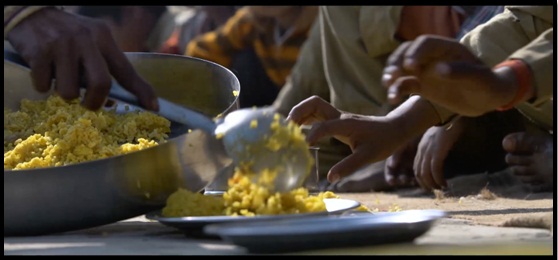
Mixed veggies with spiced rice is a staple MDM dish; they call it ‘teheri'
in UP
Agreed; but one has to remember, it's always a tough challenge to deliver food to
remote rural settlements of India. Roads are not paved, infrastructure is lacking,
and even if raw materials reach these back-of-beyond areas, kitchens to cook the
food are not available within the schools. Even where available, they are not hygienic.
But yes, when you are running something as huge as the MDM scheme in a country as
complicated as India, problems are bound to exist. What inspires me is the multifarious
attempts, especially that of the common citizens, to find solutions to these problems.
Once they start owning the scheme, there's no looking back.
And that has started happening; across the nation.
MDM BRINGS TOGETHER EDUCATION AND NUTRITION
Like Ram Sagar says,
"They are our children. Feeding them is our responsibility. All we need to
do is to take up that responsibility, and stick to it."
For the past few years, I had been travelling to a large number of schools in some
of the most remote districts of India. Since the training and documentary films
I make are for International Aid Agencies - the districts I travel are mostly remote,
impoverished and largely underserved. Most of these stories involve children and
women and other marginalized groups - hence education and nutrition invariably become
their core themes.
MDM is where these two socio-economic interests converge with each other; and, I
have to add here, wherever I have been, I have seen specks of change happening,
for the better.
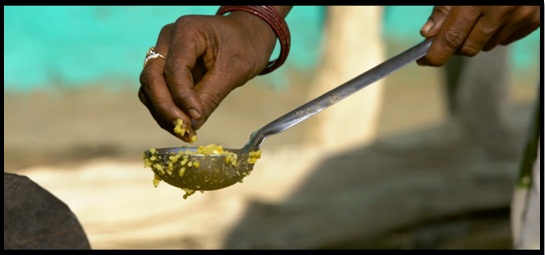
Testing whether the Teheri is fully cooked before being served; image from a school
at Nibhabari, Uttar Pradesh
For instance, at Gilouli, the School Management Committee, which is basically an
official ramped-up version of a parent-teacher committee, has assumed the responsibility.
People like Ram Sagar not only volunteer to buy the veggies, committee members also
support the cooking staff in their spare times, including tasting the quality of
the meal before they are served to children.
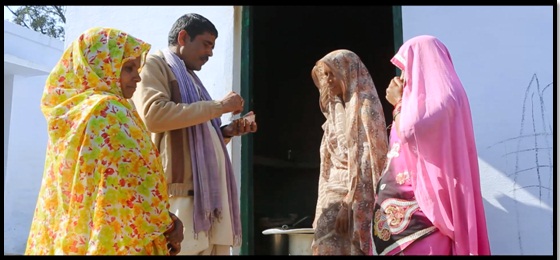
The School Management Committee, including mothers of the school children, checking
the cooked food for quality and taste.Image from Gilouli.
That's just one case; I have seen many instances of community engagement, administrative
goodwill and policies taken by the governments which raise my hope.
In Uttarakhand and Jharkhand, I have personally seen mothers do participate in the
scheme; at Andhra Pradesh, they now have kitchen gardens in school premises to grow
their own food; in Tamil Nadu, they have constructed dedicated dining halls for
mid-day meals. There must be a lot more happening. There has to be.
MDM STILL HAS A FAIR DISTANCE TO COVER
For the 11,000 Crore school
meal programme across India, everything isn't hunky-dory; it probably will never
be.
The mid-day meal program has been embroiled in recent controversies - particularly
regarding the quality and content of food in some Uttar Pradesh schools. Of course,that
I haven't been to those schools doesn't mean that they do not exist.
Since its very beginning, particularly since it's about food and children, the scheme
has often grabbed national headlines.
I quote a September 2019 news report from
Live Mint here, "An upper primary student had died and more than 60
were hospitalized allegedly after having the school meal in Jharkhand in August
2018. In July 2018, at least 30 students suffered food poisoning after having the
mid-day meal in Delhi. In October last year, 45 children in Goa were hospitalized
after having the mid-day meal. At least, 23 children had died in Bihar's Chhapra
district in 2013 after consuming contaminated mid-day meal."
The same report assures that the Union Government might consider doing an extensive
audit of the scheme. Schools from every district in India will go through an intense
review, looking at all aspects of the program - including where and how the food
grains are being procured, what is their nutritional value and whether the students
are satisfied with the content and taste of food.
That's good news. One can only hope that many more of such evaluations would be
done, and some of them will not be commissioned directly by the government. That
should surely help further enhance credibility of the new measures being taken -
to repair the chinks in the armor of the otherwise fabulous scheme.
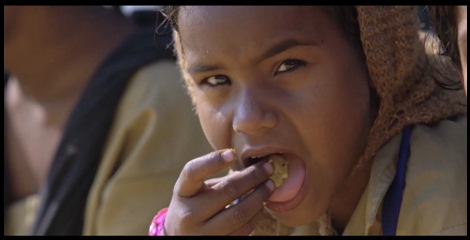
Better quality of food directly translates to better quality of learning. This image
is from Nibhabari, Uttar Pradesh.
NO OPTION BUT TO REACH THE DISTANCE
With increased community involvement
and forward looking policy decisions, I am sure the scheme is here not just to stay
but to bring forth substantial benefits - for generations that are growing, and
those yet to come.
After all, a nation stunted by a hungry and sub-nourished childhood can't possibly
hope to grow to its full potential. Wholesome and nutritious food is what our children
need. Without food, there's no positivity; without positive thoughts, there's no
future; food will help them learn and grow as responsive and contributing citizens.
At the end of it all, despite its shortfalls, let's remember, MDM is not just a
served-hot school-time lunch, but a widely appreciated (among the masses)tool for
nation building; it's representative of the inclusive growth that Indian democracy
stands for, irrespective of whoever happens to be there in the hot seat.
MDM is food for the future; our future, whoever we might be, and wherever.
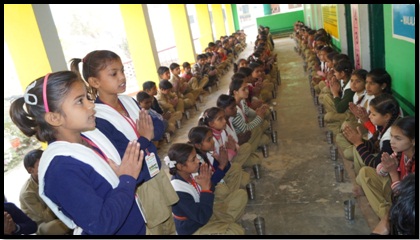
Customary prayers before the mid-day-meal, Gotha, Badayun, Uttar Pradesh
ABOUT THE AUTHOR
Anirban Bhattacharya is a creative writer and researcher of award-winning documentaries,
who runs his daily expenses through making advocacy films and creating social media
content for International AID Agencies. A certified digital content writer, he has
around 25 years of experience working in News and Current Affairs TV as a show and
story producer, with key players in the domain like Business Standard, Business
India, Zee TV, and India Today. Anirban is also an avid blogger who loves to learn
and write about ‘Screenwriting' and everything around it.
To know more about him, visit his blog
https://therewillbetime.com.
Disclaimer: The views expressed in this commentary are author's personal
observations.